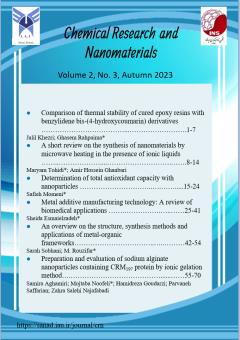Comparison of thermal stability of cured epoxy resins with benzylidene bis-(4-hydroxycoumarin) derivatives
Subject Areas : Applications of Nanostructures
Jalil Khezri
1
![]() ,
Ghasem Rahpaima
2
,
Ghasem Rahpaima
2
1 - Department of chemistry,Facuality of chemistry, islamic Azad university, lamerd branch, lamerd, fars, iran
2 - Department of Chemistry, Faculty of Chemistry, Islamic Azad University, Lamerd Branch, Lamerd, Fars, Iran
Keywords: Phoenix dactylifera, 4-hydroxycoumarin, thermal stability, Epoxy Resin, nanocomposite,
Abstract :
In this research, benzylidene bis-(4-hydroxycoumarin) derivatives were used as a curing agent to prepare epoxy resin with high performance and excellent thermal stability. For this purpose,4- benzylidene bis 4-hydroxycoumarin derivatives were synthesized using 2-aminophenol/phoenix dactylifera polymer nanocomposite catalyst. Scanning Electron Microscope (SEM) technique was used to investigate the morphology of cured epoxy resin. The comparison of parameters of degradation start temperature, residual carbon yield and kinetic parameters was done to evaluate the thermal stability of cured epoxy resin using thermogravimetric analysis (TGA). The results showed that the epoxy resin cured with 3,'3-(4-nitrobenzylidene)bis(4-hydroxy-coumarin) have a high degradation start temperature and good carbon efficiency rather than other derivatives. After the 4-nitro derivative, the 4-chloro, 4-fluoro and 4-methyl derivatives have higher thermal stability. So it can be said that the nitro group has provided higher thermal stability rather than chloro, fluoro and methyl groups for cured epoxy resin. As a result, benzylidene 4-hydroxycoumarin derivatives bring high thermal stability to cured epoxy resin due to having aromatic rings
1. P.K. Balguri, D.G. Harris Samuel, U. Thumu, Mater. 44, 346-355 (2021).
2. H. Nazarpour-Fard, K. Rad-Moghadam, F. Shirini, M.H. Beheshty, G.H. Asghari, Polimery. 63, 253-263 (2018).
3. F.L. Jin, X. Li, S.J. Park, J. Indust. Eng. Chem. 29, 1-11 (2015).
4. H.Q. Pham, J.M. Maurice, Epoxy resins, Ullmann's Encycl, Ind. Chem. 156‒244 (2000).
5. S. Montserrat, M. Jiří, Thermochim. Acta. 228, 47-60 (1993).
6. K. Liu, L. Sun-Mou, H. Jin-Lin, H. Kuo-Huang, Polym. Compos. 41, 4277-4287 (2020).
7. H. Du, C.X. Zhao, J. Lin, J. Guo, B.Wang, Z. Hu, Q. Shao, D. Pan, E.K. Wujcik, Z .Guo, Chem. Record, 18, 1365-1372 (2018).
8. L. Zhang, H. Jiao, H. Jiu, J. Chang, Sh. Zhang, Y. Zhao, Compos. 90, 286-295 (2016).
9. I. Yarovsky, E. Evans, Polymer. 43, 963-969 (2002).
10. M. Vafayan, M.H.R. Ghoreishy, H. Abedini, M.H. Beheshty, Iran. Polym. 24, 459-469 (2015).
11. H.G. Waddill, W.Y. Su, Accelerator for curing epoxy resins (1993).
12. O. Hara, Three Bond Technical News. 32, 1-10 (1990).
13. M.R. Nazarifar, G. Rahpeima, J. Khezri, Iran. Chem. 40 (1), 45-53 (2021).
14. H.H. Horowitz, G.A. Metzger, Anal. Chem. 35, 1464 (1963).
15. A. Broido, Polym. Sci. Part A-2: Polym. Phys. 7, 1761 (1969).


